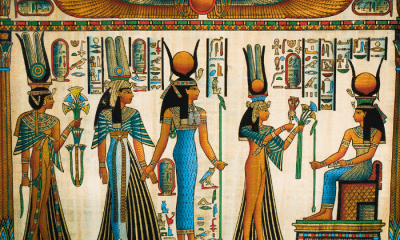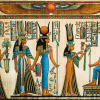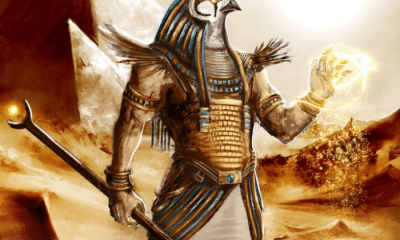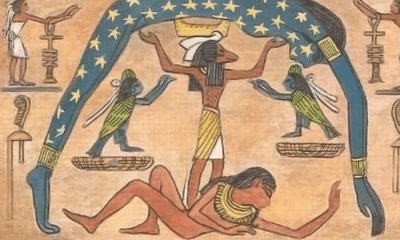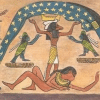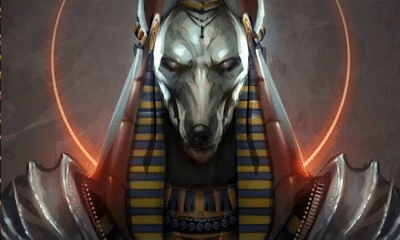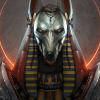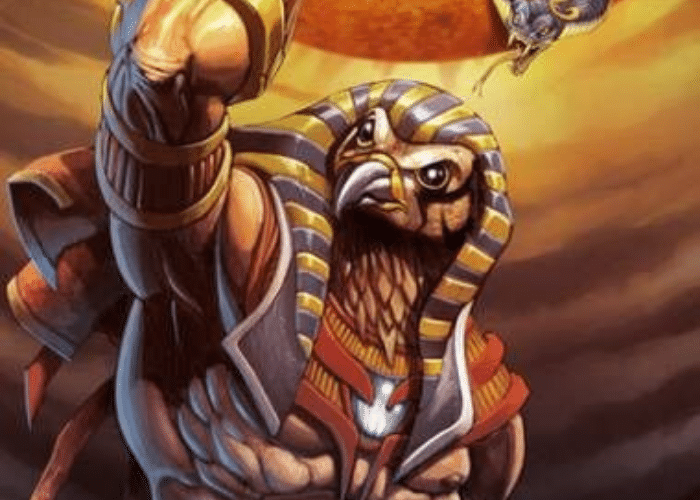
Egyptian
Amun: The King of the Egyptian Gods
Amun: The King of the Egyptian Gods
In ancient Egypt, Amun was such an important god that his cult became nearly monotheistic. Keep reading to learn how the local god of Thebes absorbed the identities of many of Egypt’s other key gods.
While we often think of the ancient Egyptians as having a single pantheon, there were many different gods and legends to be found.
Egypt was a large kingdom, so local variations in the religion existed along the Nile. More importantly, it was one of the world’s longest-lasting cultures that developed and changed over time.
While these changes can be found in many parts of the ancient Egyptian religion, it is perhaps most evident in the character of Amun. Once a local creator god, his cult became so important that it all but swallowed up many of the Empire’s other central gods.
Amun, also spelled Amen, Amon, or Ammon, because as the protective patron of the city of Thebes. Over the course of thousands of years, however, his influence expanded not only through Egypt but to many other countries as well.
How did a local wind god become the king of the empire’s religion? The answer lies with the changing politics of Egypt through its long and tumultuous history.
How Amun Rose to Power
By the First Intermediate Period, the culture of Egypt was already nearly a thousand years old. The Old Kingdom dynasties had unified the Nile Valley, established far-reaching trade, and built the Giza Pyramids in a time of peace.
By about 2180 BC, however, the stability of the Old Kingdom had dissolved. A series of competing kings and minor warlords divided Egypt for a little over a hundred years.
During this period, one of the most stable places in the region was the city of Thebes. There, the local god of wind rose to prominence.
Amun was part of a trio of regional gods who protected the city and its rulers. Eight hundred miles from the Mediterranean, the trading city was largely sheltered from the north and the power struggles there.
Thebes took control over the southern areas of Upper Egypt, the areas furthest from the Nile Delta. Their protector god, Amun, became important in the regions they controlled but was largely unknown in the rest of Egypt.
The cult of Amun became more widespread with the first Middle Kingdom kings in the 11th Dynasty. These kings, who claimed descent from a Theban prince, reunified Egypt and established the southern city as a religious center.
Temples were built in honor of many gods. When people came from throughout Egypt to worship there, they were introduced to the local protector god and his wife, Mut, as the parents of the moon god Khonsu.
A few hundred years later, the 18th Dynasty came to power after another period of instability and foreign rule, ushering in the New Kingdom. Its first Pharoah, Ahmose I, chose his city of origin, Thebes, as the new center of political power.
With Thebes as the capital and the throne in the hands of one of its citizens, the area’s local beliefs took on new importance.
Amun had been revered as the protector of the city for over 1,500 years. Now that Thebes was the capital, this made him the protector of all of Egypt.
The god also became a symbol of Egyptian unity and national power. Ahmose I had defeated foreign rulers, the Hyskos, so Amun came to be the patron of all people and classes who were oppressed.
This connection to the Pharoah and the seat of power began the evolution of Amun from one of many gods to the ultimate symbol of divinity in New Kingdom Egypt.
My Modern Interpretation
The kings of Egypt had associated themselves personally with the gods long before Ahmose I moved the capital to Thebes. They claimed to be descendants of Horus, the son of Osirus and grandson of Ra.
Ra had been the first king of the Egyptian gods. His grandson, Horus, took his place as both king and the god of the sun after Ra went to the Underworld.
The Egyptians believed that the king inherited both divinity and special protection from his ancestors. He was not just a ruler, but the embodiment of their chief gods.
The 18th Dynasty, however, already had a protector before they took the throne. As natives of Thebes, they saw Amun as the protector of their home and leadership.
The cult of Amun was still minor in the rest of Egypt, but it was far too old and powerful in Thebes to simply be replaced by that of Ra. Instead, the two gods were combined.
In Thebes itself, Amun remained the most important god. But throughout the kingdom, he was rebranded as Amun-Ra, another aspect of the god of the Pharaohs.
In most of Egypt, both Ra and Amun’s cults became so intertwined that the two were completely inseparable. Their names were used interchangeably throughout the New Kingdom and, under the influence of the Theban court, Amun’s iconography and his name became more closely associated with the king than those of Ra.
The fact that Amun was a southern god also helped him expand beyond Egypt’s traditional borders.
With seas to the north and east and a vast desert to the west, when the kingdom expanded it did so to the south. During the New Kingdom, Egypt officially took control of its southern neighbors, Kush and Nubia.
The people of Kush adopted much of the religion of their new rulers. They identified Amun, the god of kings, with their own chief deity.
This god had always been depicted with the head of a ram, and this iconography made its way back to Egypt. The influence of Kush led to Amun being shown with spiral horns.
In Egypt, rams had traditionally been associated with fertility and virility. Already associated with Ra, the creator god, Amun came to be revered as the maker of both animals and mankind.
In the forms of Amun-Ra and Amun-Min, his aspect as a creator associated with the god of fertility, the once-local god became the chief deity of the pantheon. He was now the god of the sun and the creator, and his association with the Pharoah made him a god of law, truth, and justice.
Amun’s power became so all-encompassing that some historians have described the New Kingdom as being nearly monotheistic. The cult of Amun merged with so many others that almost all aspects of the world fell under his authority.
Amun’s importance is evident in the writings of other contemporary cultures. Ammon, the Greek spelling of the name, is mentioned in the Bible as a false god and was worshiped in Greece and Rome, either as Ammon or as an aspect of Zeus.
Belief in Amun became so powerful and widespread that it lasted outside of Egypt even after the kingdom became a vassal state of Rome.
In both Nubia and Sudan, evidence of temples to Amun, under the local name Amani, shows that his cult persisted until at least the 1st century AD. Diodorus Siculus, a Roman writer of the 1st century BC, said that the Nubian government was entirely controlled by the priesthood of Amun.
In Libya, the cult of Amun was introduced by the Greeks and soon became centered on an oasis oracle. As late as 540 BC, Byzantine sources mentioned a Berber group worshipping Ammon as the father of their own chief god.
In Greece, temples to Ammon were built in Sparta and Megalopolis. A statue of him was dedicated at Delphi and the poet Pindar wrote odes in praise of the Egyptian god.
The Romans identified him with their own chief god, Jupiter. Ammon-Jupiter was widely worshipped in Latin North Africa, where his name passed into our own language.
Ammonium chlorite was named not only for the place it was gathered, near a Libyan temple to Ammon-Jupiter, but also for the spiral shape of the fossils found around it. Ammonites, the prehistoric shelled creatures that created these fossils, were so named because their shape resembled the ram’s horn that was still associated with Ammon in Rome.
Part of the brain was also named for this spiral shape. The cornu ammonus, or “horns of Ammon,” makes up part of the hippocampus.
Amun began as a relatively local god in an Egyptian city that was, in early eras, of minor importance. The politics of the New Dynasty, however, meant that he became a chief deity not only in the Nile Valley, but in the many other cultures the Egyptians came into contact with.
In Summary
Amun began as the local god of wind in Thebes, but over time his cult spread beyond southern Egypt.
Thebes became increasingly powerful after the First Intermediate Period and its influence was eventually expanded through both Upper and Lower Egypt. As a religious center in the 11th Dynasty, the city promoted the cult of Amun.
The 18th Dynasty, however, saw the greatest increase in the god’s influence when a Theban native became Pharaoh. He moved the capital of the empire to his home city, making its local culture suddenly more central to Egypt as a whole.
Amun had long been regarded as a protector of the city, but now he was thought of as a protector of the Pharoah and, thus, of all of Egypt.
This role had traditionally been held by the sun god Ra. The cults eventually merged, resulting in the worship of Amun-Ra.
Amun’s cult also became associated with the god of fertility, Min. As Amun-Ra and Amun-Min, he was so central in Egyptian religion that some scholars described the New Kingdom as nearly monotheistic.
The New Kingdom was also a time of expansion for Egypt, resulting in the cult of Amun spreading far beyond his traditional homeland. He remained a popular god in Sudan, Nubia, Libya, Greece, and Rome long after the power of the Egyptian kings had waned.


